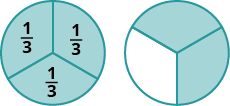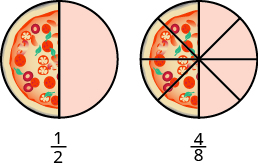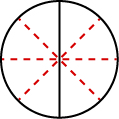| << Chapter < Page | Chapter >> Page > |
A more thorough introduction to the topics covered in this section can be found in the Prealgebra chapter, Fractions .
Fractions are a way to represent parts of a whole. The fraction means that one whole has been divided into 3 equal parts and each part is one of the three equal parts. See [link] . The fraction represents two of three equal parts. In the fraction the 2 is called the numerator and the 3 is called the denominator .

A fraction is written where and
A fraction represents parts of a whole. The denominator b is the number of equal parts the whole has been divided into, and the numerator a indicates how many parts are included.
If a whole pie has been cut into 6 pieces and we eat all 6 pieces, we ate pieces, or, in other words, one whole pie.

So This leads us to the property of one that tells us that any number, except zero, divided by itself is 1.
Any number, except zero, divided by itself is one.
If a pie was cut in pieces and we ate all 6, we ate pieces, or, in other words, one whole pie. If the pie was cut into 8 pieces and we ate all 8, we ate pieces, or one whole pie. We ate the same amount—one whole pie.
The fractions and have the same value, 1, and so they are called equivalent fractions. Equivalent fractions are fractions that have the same value.
Let’s think of pizzas this time. [link] shows two images: a single pizza on the left, cut into two equal pieces, and a second pizza of the same size, cut into eight pieces on the right. This is a way to show that is equivalent to In other words, they are equivalent fractions .

Equivalent fractions are fractions that have the same value.
How can we use mathematics to change into How could we take a pizza that is cut into 2 pieces and cut it into 8 pieces? We could cut each of the 2 larger pieces into 4 smaller pieces! The whole pizza would then be cut into pieces instead of just 2. Mathematically, what we’ve described could be written like this as See [link] .

This model leads to the following property:

Notification Switch
Would you like to follow the 'Elementary algebra' conversation and receive update notifications?